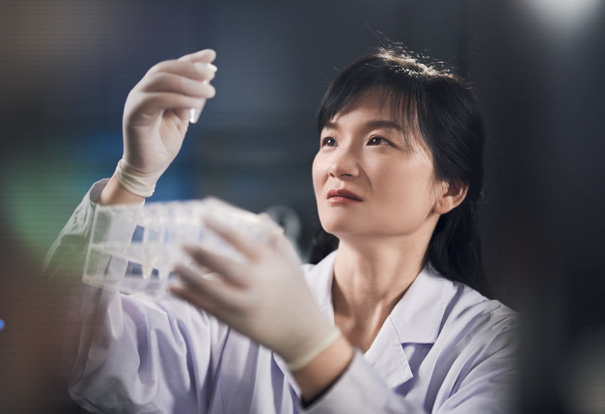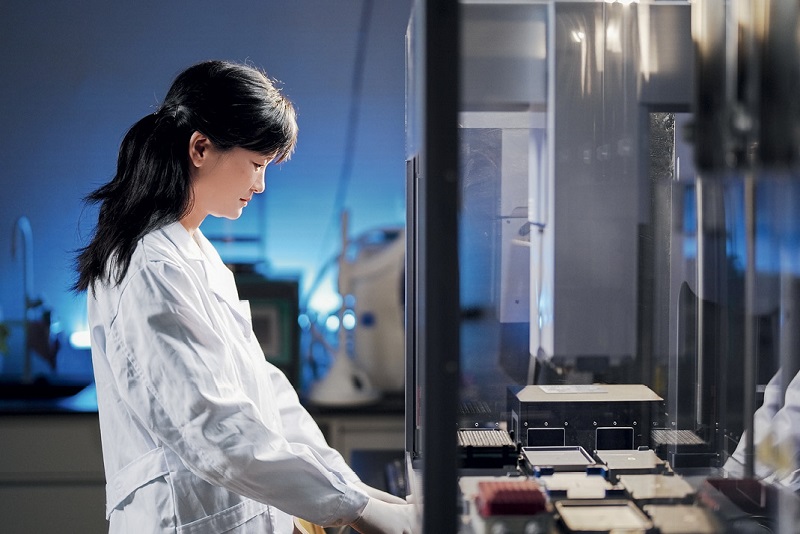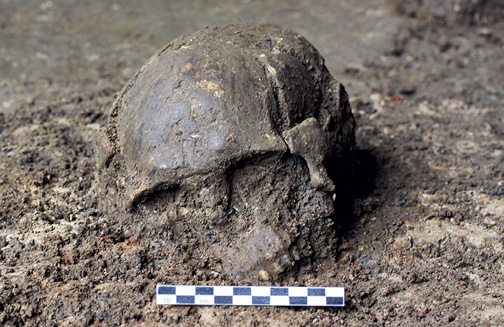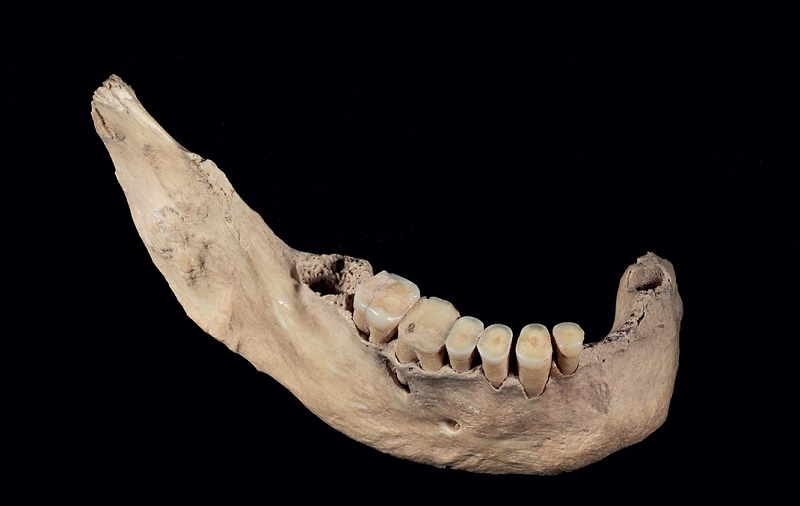Chinese paleogeneticist Fu Qiaomei was awarded the UNESCO–AI Fozan International Prize for the Promotion of Young Scientists in Science, Technology, Engineering and Mathematics (STEM) on June 19, 2023 in Paris, for her “seminal work on the history of early humans in Eurasia based on genetic lineage studies, which provides new insights into the early human history of Eurasia and perspectives on the evolution of human health.” As one of the leading paleogeneticists in the world, Fu was selected from 2,500 candidates worldwide, and became the first Chinese recipient of this title.
Born in 1983, Fu is now a professor and director of the Molecular Paleontology Laboratory at the Institute of Vertebrate Paleontology and Paleoanthropology (IVPP) of CAS in Beijing. Her research focuses on providing insights into the genetic history of humans. To date, she has authored 63 publications in international SCI journals, as the first or corresponding author in 36 of them, including three in Nature, four in Science and three in Cell. Fu has also won a number of other awards. She was selected as one of “10 Science Stars of China” by Nature magazine for her success in promoting the understanding of human evolution. She also received the “17th Award for Young Women in Science” from the National Commission of the People’s Republic of China for UNESCO, as well as the “Tan Kah Kee Young Scientist Award in Life Sciences 2022” from the Tan Kah Kee Science Award Foundation, among other honors.

Fu Qiaomei is preparing samples for the automated workstation.
Where Do We Come From
Ancient DNA research is an emerging and cutting-edge field that studies how humans have evolved, and how this evolution has affected present-day humans through relevant genetic information extracted from human remains, or site deposits, dating back to hundreds of thousands to millions of years.
“My work aims to provide insights into the genetic history of humans, including probing what human groups lived in the past, their spatial and temporal distributions, and the evolutionary characteristics and migratory interactions at different stages of time,” Fu explained.
“Our understanding of the genetic history of humans in Eurasia has changed dramatically through ancient DNA research. During the past decade, we have discovered rich and diverse groups of early modern humans that have existed in the past.” Fu said that these studies have revealed the genetic characteristics and dynamic evolutionary history of early modern humans in Eurasia.
Another key finding by her team is the evolvement of early East Asian populations. Fu discovered new population dynamics, including unknown human populations with little or no relationship to present-day humans and an origin of proto-Austronesians in south China. These studies filled important gaps in human history and have provided new angles on the evolvement of prehistoric populations in southern and northern East Asia.

Fu Qiaomei is conducting experimental analysis in her lab.
“Fishing” for Ancient DNA
For paleogeneticists, it is difficult to find ancient DNA samples, and it is even more difficult to extract extremely minute genomes from ancient DNA materials that have degraded over a long period of time, because ancient DNA fragments have been “irreversibly” shortened over time, and they have been “invaded” and contaminated by a large number of environmental microorganisms from the outside world, as well as by the DNA of modern human beings, which adds difficulty in identifying them.
In 2013, Fu co-developed nuclear DNA capture technology, with paleogeneticist Matthias Meyer, a feat which was previously considered “impossible.” Fu describes this technology as “fishing.” “That’s what we call fishing. We capture very minimal amounts of DNA from a large number of microorganisms by pulling it out,” she said. Later in 2015, Fu led the design of a 1240K probe set that is capable of accurately tracking ancient DNA. By virtue of these two technological methods, a number of samples that had not been able to be examined were brought into laboratories and research on sequencing ancient human DNA became possible. Today, more than 70 percent of the world’s ancient human genomes are captured by these methods, and it is these technological innovations that have made it possible to obtain relevant data from human samples that have been poorly preserved in the warm, humid, and acidic soil environments in south China.
In 2014, a research team led by Fu obtained ancient human DNA data dating back more than 8,000 years in the Liangdao Island in south China. Some significant conclusions were drawn from this key discovery, after comparing it with the ancient human DNA obtained in east China’s Shandong Province. Although the Liangdao Island is only 24 kilometers from Fuzhou, a coastal city in southeast China’s Fujian Province, the special geographical location of Liangdao as an island makes Fu wonder: can the individual group living on Liangdao represent the whole southern population? Are they different from the ancient populations on the southern mainland? Based on systematic research concepts and driven by the spirit of rigorous scientific research, Fu’s team spent nearly five years analyzing the samples in south China, and finally obtained more than 10 ancient human genomes in Fujian, including those of the Qihe Cave People dating back more than 8,000 years. This finding proved to be a major contribution to the tracing of the southern ancestor groups in China and the origins of the proto-Austronesians family.

A fossil skull of an 8,400-year-old Qihe individual.
Human Evolution in East Asia
Prior to 2017, human ancient genome data and related research were mainly concentrated in Europe and North Asia, and related research was extremely scarce in East Asia, especially in China. The genetic evolution and migratory integration of East Asian populations became the “missing link” in the human evolution process.
In 2017, Fu led a team to capture and sequence China’s first human ancient genome, the 40,000-year-old Tianyuan Cave People genome in Beijing, which is also the earliest research result of modern human genomes in East Asia to date. The study demonstrates that Tianyuan Cave People already presented Asian genetic characteristics and had a special genetic link with a certain group of ancient European people. It reveals the genetic diversity of the early East Asian populations and the complexity of evolutionary history, and ushers in the era of the study of ancient DNA of East Asian populations. The study has commanded attention in global academia, while the journal Science believes it fills a huge gap in geography and time concerning East Asia.
Later in 2020, Fu carried out a systematic study of the ancient genomes of China’s southern and northern populations. This research led to the discovery of the pattern of north-south differentiation of China’s populations over the past 10,000 years, the genetic continuity of the major population, and the history of migratory integration. For the first time, it confirms, from a genetic point of view, that the Amis and the Atayal on the Taiwan Island, and the Austronesian represented by the islanders on the southwestern Pacific Ocean are directly related to the mainland populations in southern coastal regions of China, such as Fujian, 10,000 years ago.
In 2021, Fu Qiaomei obtained 30 pieces of 11,000-year- old human genomes from Guangxi Zhuang Autonomous Region in south China. This finding discovers previously unknown local modern populations in Guangxi and brings new insights into the genetic exchange between populations in south China and Southeast Asia. These ancient human genomes from the southern region have also been considered to fill a gap in ancient human evidence in this region.
In the same year, Fu led a team to unlock the dynamic genetic map of Ice Age populations in China for the first time, by analyzing the ancient genomes of human beings in Beijing and northeast China’s Heilongjiang Province dating back over 40,000 years. It provides new evidence for the selection features of the adaptation genes carried by East Asians. The team found that the Tianyuan Cave People were widely present before the Last Glacial Maximum, but its population dropped massively at the end of that period. It reveals that the emergence of ancient northern populations in Heilongjiang 14,000 years ago was the most direct source of the East Asian genes carried by Native Americans. The mystery of migratory differentiation of Asian populations was unraveled step by step, and the study was rated as a landmark breakthrough in the field of Paleogenomics.
Fu has also led her team to explore the important areas of multicultural exchange in China. In 2022 and 2023, they conducted large-scale studies on the populations in Xinjiang and the Qinghai-Tibet Plateau over the past 5,000 years, revealing in detail their origins, their formation processes, and the history of their complex interactions with people of other regions.
In tracing the possible existence of ancient humans in the Paleolithic era, Fu’s team found another way to capture genomes of even older people from the soil. In 2020, the team obtained the first case of Denisovan DNA in East Asia, through experimental analysis of the sediments sampled from the Baishiya Karst Cave on the Qinghai-Tibet Plateau. This is the first successful case of Chinese sedimentary ancient DNA research, and is also the world’s first genetic evidence of Denisovan DNA discovered outside the Denisovan Cave, which provides key evidence for clarifying the spatial and temporal distribution of this extinct ancient people, whose physical characteristics remain unclear.
Fu explained, “The Baishiya Cave is located at a relatively high altitude of about 3,200 meters, and it was challenging for ancient humans to live at such a high altitude 100,000 years ago. The finding provides important clues for us to further explore human adaptation genes (genes that adapt to specific environmental conditions by regulating certain physiological functions of a group), such as certain genomes carried by modern Tibetans who lived in a low-oxygen environment at high altitude.”
A Passion-Driven Commitment
“My motto has always been ‘set no limits, never give up, and stay curious,’ and this belief has inspired me to this day,” said Fu. “I was a curious kid when I was little. I was obsessed with the mysteries of history and wondered how the past shapes our present and future. It was this curiosity that pushed me to the field of genetics and pursue a career in ancient DNA research.”
Fu majored in cultural relics protection technology in college, where she studied mathematics, physics, chemistry and computer science. After receiving an undergraduate degree, she chose to conduct bone research at the Chinese Academy of Sciences in the field of biology, something that had always fascinated her. These academic experiences laid the foundation for her future research on ancient DNA.
During her pursuit of a PhD, she studied evolutionary genetics at the Max Planck Institute for Evolutionary Anthropology in Germany. Her mentor was Svante Pääbo, a prominent figure in the field of ancient DNA and a Nobel Prize laureate. “Back then, students needed to be assessed for six months to see if they were fit to do a PhD. After the initial assessment, we had to be assessed once a year, and if the institute didn’t renew our admission, we couldn’t study there anymore.” Fu recalled that since she was studying an unfamiliar subject, it was new territory for her getting to grips with literature reviews, methodology and research topics. She didn’t flinch in the face of difficulties, but tried to do as much as possible against all odds. “I just wanted to try my best, as I think if I really can’t do well, I won’t blame myself, but if I fail to try hard enough, then it’s a different matter.” With this simple thought in mind, she immersed herself in a sea of literature and experiments, taught herself programming, and performed many bioinformatic analyses. Her hard work eventually paid off. She passed all her exams and earned recognition from other researchers. Her mentor, Pääbo, called her “one of my best students” in a media interview.
In 2010, Fu was responsible for the establishment of the Sino-German Joint Ancient DNA Platform. At the end of 2015, she officially returned to China, and in January 2016, she took up the position of director of the Ancient DNA Laboratory (now the Laboratory on Molecular Paleontology) at the Institute of Vertebrate Paleontology and Paleoanthropology of the Chinese Academy of Sciences (ICVPAS), and began to dive into the study of the genetic evolution of the ancient populations in East Asia, for which there has been a gap in knowledge even in the global arena. With passion, she approached her dream methodically and made steady progress.

The mandible of the Tianyuan Cave individual. Photos courtesy of IVPP, CAS
Exploring Uncharted Territory
Today, Fu’s research team remains dedicated to exploring more efficient molecular paleontology experimental techniques and analytical methods, as well as carrying out sampling and research over a larger spatial and temporal span, in order to better understand the evolution of human beings in East Asia. These efforts will help to further unravel the mysteries of human history and provide important insights for the future development of humankind.
Regarding the direction of future research, Fu acknowledges that there remain some riddles about the evolution of East Asian people, and there are many missing historical clues and details to be further explored. For Fu, her curiosity for the unknown and her enthusiasm for further exploration is still strong, “Is it possible that one day, based on research, to discover the ancient humans native to East Asia? What were the crowds like at the end of the Last Glacial Maximum more than 20,000 years ago? What is the relation between different populations and cultures? How did our different ethnic groups come into being? There’s a lot more to keep working on.”